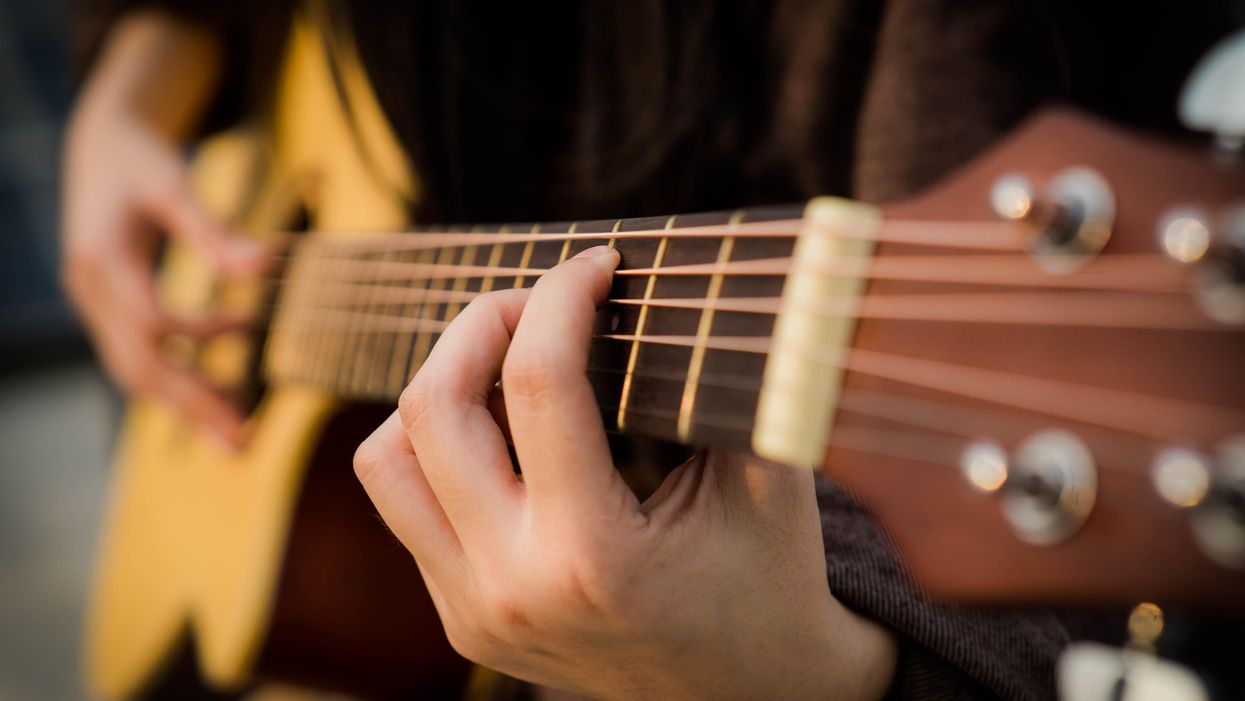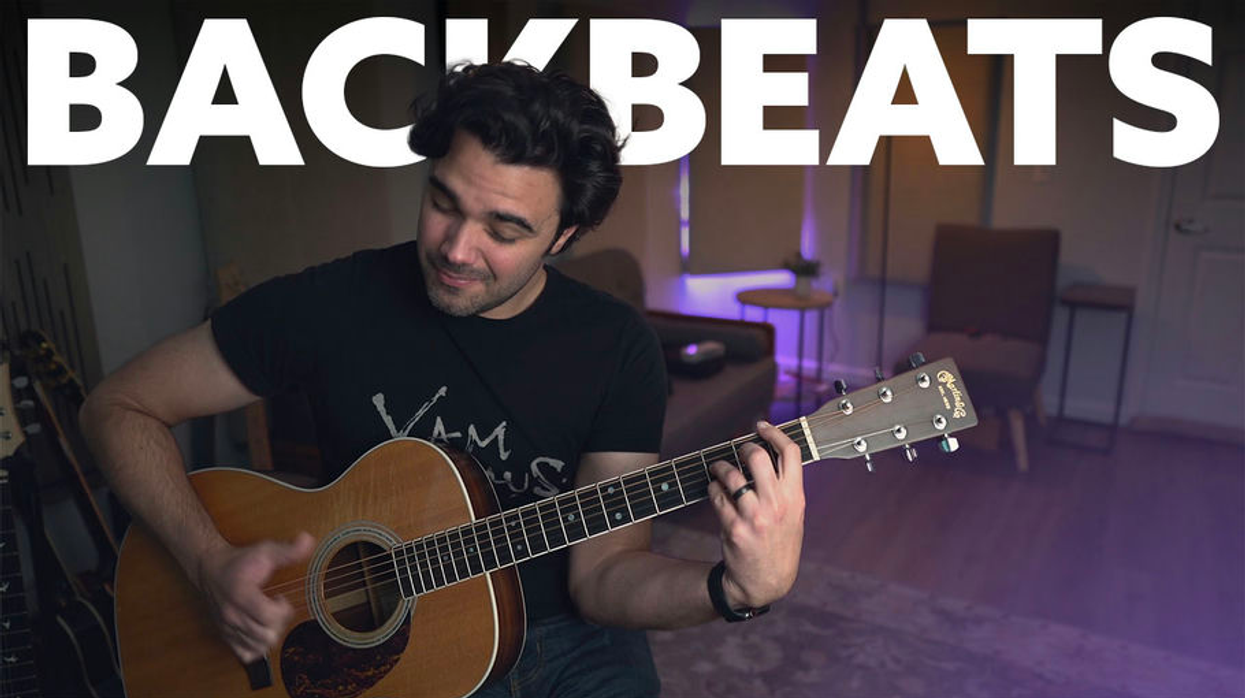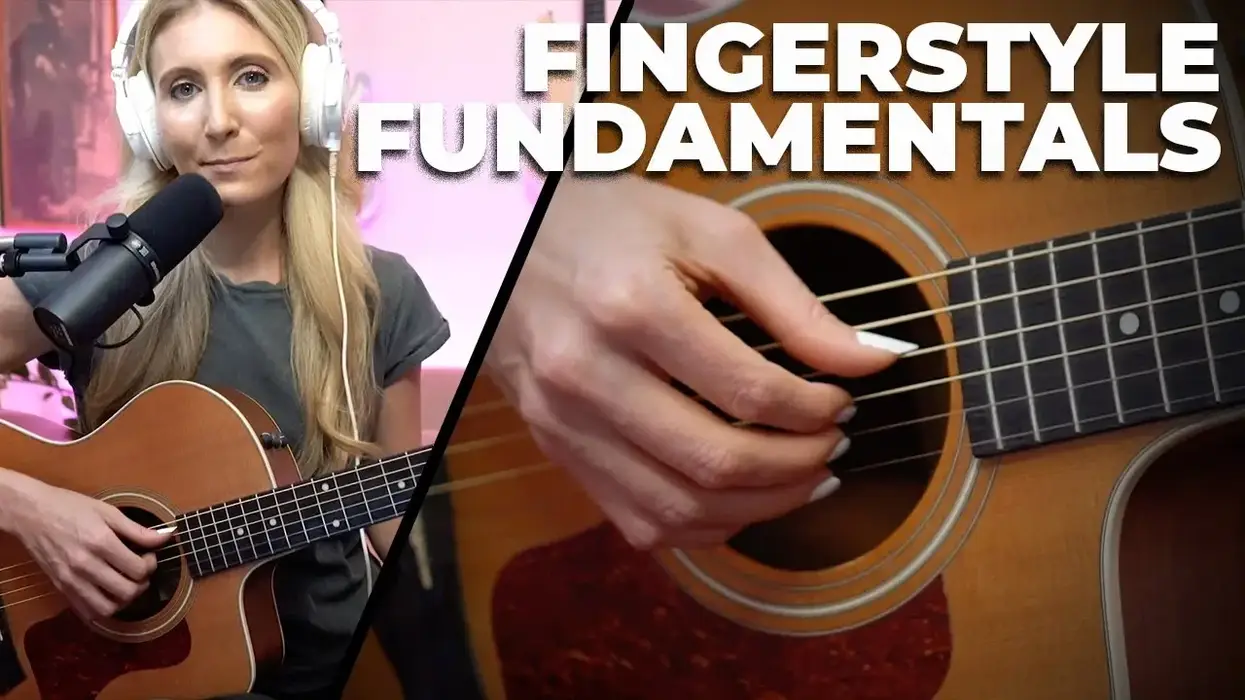Strumming great rhythm guitar is a core skill. It’s never too soon—or too late—to get a solid groove going. With a few simple chord shapes, you can be up and running rather quickly. (You can even tune your guitar’s open strings to a chord and simply strum the open strings.) Players like Neil Young, Kurt Cobain, Noel Gallagher, and Jimmy Page all have an individualized approach to simple strums. Let’s dig in and tighten up our rhythm chops.
These music examples use a variety of basic chords and progressions, but if they’re still too challenging, don’t give up. Pick any chords you like and try them. Listen carefully to the recorded examples so that you can pick up details about the sounds we’re going for. Strumming is typically done with a pick, so I’ll recommend that approach. There are certainly strummed styles that use fingers, such as the elegant and sophisticated flamenco techniques and the unique and personal approaches of people like Jack Johnson or Tommy Emmanuel. Explore those but do try for some practice time with the pick.
Let’s begin with some basic symbols, terms, and notation systems.
We have downstrokes and upstrokes. A downstroke means the pick moves toward the floor. In this case it strikes the lowest strings first. Upstrokes are simply the reverse; you start by striking the higher strings first.
Let’s start by simply strumming an E minor chord with downstrokes (Ex. 1). We’ll strum once per beat. You can see the musical notation shows quarter-notes in 4/4 time. The downstroke symbol is used to remind you of the strum direction. Hold your pick loosely enough to pass quickly through the strings. We want the illusion that all the strings are being struck at the same time. Of course, the notes are staggered, but it shouldn’t sound that way. Strive for an “instant” sound.
Ex. 1
A light grip of the pick and a swift strum through the strings gives us a rhythmically precise and tight sound.
Does your strum sound like that? Great! If it doesn’t, it might be because your strum is a drawn-out motion that results in a harp-like effect, which lacks crispness and rhythmic precision. Save this for the last chord of a song or for an isolated effect. Not much groove happening in this version.
Neil Young - Cortez The Killer (Acoustic)
Upstrokes are usually reserved for upbeats. Thus, it’s common to incorporate eighth-notes with up strokes. A rule of thumb: Use downstrokes on the downbeats (1, 2, 3, 4) and upstrokes on the “and” or each beat. If you are tapping your foot to the beat, the pick direction will match your foot’s movement. In Ex. 2 you’ll see the rhythmic notation with pick strokes.
Ex. 2
It’s reasonable to assume that you must play all the strings with each stroke. While that’s possible, it’s not so common. Typically, the downstrokes favor the lower strings and the upstrokes favor the high strings. You don’t have to be super accurate. The beauty of this is that a bit of randomness makes it sound more human and more musical. Listen to Ex. 3 for the differences between this version and Ex. 2.
Ex. 3
Nirvana - About A Girl (MTV Unplugged)
Let’s do another example (Ex. 4), but this time with a chord change. Notice that the very last chord before the change is simply a few open strings. No one can change chords instantaneously, so it’s common to “cheat” like this: Use the last upstroke as your time to change chords. If you listen closely to some favorite songs, you might be surprised to hear how often this happens.
Ex. 4
Once the basic movements are comfortable, it’s time to add rhythmic variation (Ex. 5). Since we’ve been playing constant eighth-notes, we’ll now remove a strum—variety can be created via omission. Try this by “missing” the strings. In other words, keep your strum movement going, still up and down, matching the beat—just avoid the strings for a “miss.” Remember downstrokes are on the beat, upstrokes for the “ands.”
Ex. 5
Here’s another common rhythm, where we are “missing” one more strum (Ex. 6). Listen for which strings are struck with the downstroke and the upstroke.
Ex. 6
Noel Gallagher “Wonderwall” Live on the Stern Show (1997)
The previous two examples omit the sound of a couple of upstrokes, but we can also omit a downstroke (Ex. 7). This will create a syncopated rhythm. Syncopation is created by having an upstroke that is not followed by a downstroke. This helps to accent different parts of the measure.
Ex. 7
It’s time to notice details about musical stresses—what we call accents. A typical acoustic groove often mimics the feel of a good drumbeat. The low strings can act like a bass drum and the high strings can act like the snare drum. Basic drum beats often have bass drum on beats 1 and 3 and snare drum on 2 and 4. Ex. 8 is a simple way to adapt that to the guitar. Accents can be achieved by playing a certain chord louder or by striking more notes in a given chord. Adding some upbeats to this approach is like adding a ride cymbal or hi-hat to the groove.
Ex. 8
We can accent certain strokes and create interesting rhythms that way—even when there’s a seemingly bland rhythm, as in Ex. 9. Variety and interest are achieved through dynamics (musical volume) and accents. We can create a vibrant and intensely varied part that is anything but mechanical. The long wedge symbol is a crescendo, which means to gradually get louder. The symbols that look like “greater than” are accents.
Ex. 9
Ex. 10 is a variant of Ex. 9. Instead of eighth-notes (two strums per beat), we have 16th-notes (four strums per beat). The tempo is moderately slow, but it’s still quite busy. Remember, you don’t have to strike all the strings of the chord. Downstrokes favor low strings and upstrokes favor high strings. As with the previous example, an interesting rhythm is created via accents.
Ex. 10
Once you’re comfortable with your strums, it’s time to add rests. Rests are silences. We can use rests to add variety, since it can be tedious to have endless sound that’s not contrasted by silence. Rests are typically “played” by landing the pinky side of your hand on the strings. No worries if the rest makes a click sound, that can even be desirable. Try Ex. 11 for a simple exercise with rests.
Ex. 11
Sometimes the rest gets replaced with a percussive sound. Think of it like a “crash” into the strings: Your palm lands on the strings and the pick hits right after. It’s fine for the pick to hit just a couple of strings. This is a good way to mimic certain songs. Check out Ben E. King’s “Stand by Me.” There’s no guitar on that recording but you can emulate the percussion by playing Ex. 12.
Ex. 12
Ex. 13 is a good generic rock groove. I think of this as something akin to a basic drumbeat. This strum is useful whenever you need a driving groove.
Ex. 13
Being able to do a steady, eighth-note strum with a good feel and stamina takes time, so be patient! Practicing with a metronome or drum beat (there’s tons of smart phone apps and loops on YouTube) is great for developing your skills, so definitely work that in. Have fun!






















